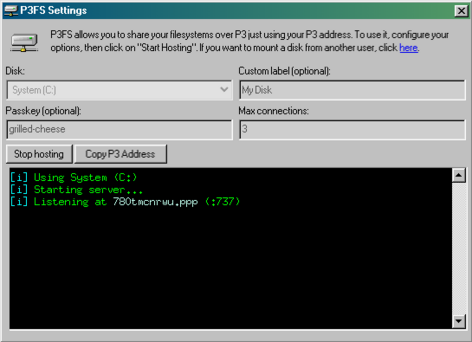From Wiki96
Themirrazz (talk | contribs) (Created page with "P3FS is a feature introduced in Windows 96 Lite that allowed you to mount a filesystem from another user's computer via P3. Despite P3FS being released in Windows 96 Lite, the software required to host a P3FS was introduced in v3 during the beta program. Filesystems mounted using P3FS are live, and can require a password for extra security. However, due to tiny delays in WebSockets and Socket.io, P3FS filesystems are the most slow filesystem (j...") |
m (Reverted edits by 94.233.241.205 (talk) to last revision by Utf) Tags: Replaced Rollback |
||
| (2 intermediate revisions by 2 users not shown) | |||
| Line 1: | Line 1: | ||
P3FS is a feature introduced in [[Windows 96 Lite]] | [[File:P3FS Settings.png|thumb|472x472px|P3FS]] | ||
P3FS is a feature introduced in [[Windows 96 Lite]] to host and mount network filesystems over [[P3]]. | |||
Users can optionally specify a drive label and password for users to connect. | |||
=== Limitations === | |||
Due to latency, speed issues and shortcomings of P3, hosted drives are often slower than ROFS filesystems. | |||
Latest revision as of 17:38, 16 May 2023
P3FS is a feature introduced in Windows 96 Lite to host and mount network filesystems over P3.
Users can optionally specify a drive label and password for users to connect.
Limitations
Due to latency, speed issues and shortcomings of P3, hosted drives are often slower than ROFS filesystems.
